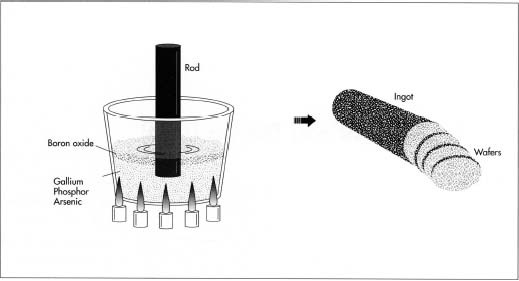Light-emitting diodes (LEDs)—small colored lights available in any electronics store—are ubiquitous in modern society. They are the indicator lights on our stereos, automobile dashboards, and microwave ovens. Numeric displays on clock radios, digital watches, and calculators are composed of bars of LEDs. LEDs also find applications in telecommunications for short range optical signal transmission such as TV remote controls. They have even found their way into jewelry and clothing—witness sun visors with a series of blinking colored lights adorning the brim. The inventors of the LED had no idea of the revolutionary item they were creating. They were trying to make lasers, but on the way they discovered a substitute for the light bulb.
Light bulbs are really just wires attached to a source of energy. They emit light because the wire heats up and gives off some of its heat energy in the form of light. An LED, on the other hand, emits light by electronic excitation rather than heat generation. Diodes are electrical valves that allow electrical current to flow in only one direction, just as a one-way valve might in a water pipe. When the valve is "on," electrons move from a region of high electronic density to a region of low electronic density. This movement of electrons is accompanied by the emission of light. The more electrons that get passed across the boundary between layers, known as a junction, the brighter the light. This phenomenon, known as electroluminescence, was observed as early as 1907. Before working LEDs could be made, however, cleaner and more efficient materials had to be developed.
LEDs were developed during the post-World War II era; during the war there was a potent interest in materials for light and microwave detectors. A variety of semiconductor materials were developed during this research effort, and their light interaction properties were investigated in some detail. During the 1950s, it became clear that the same materials that were used to detect light could also be used to generate light. Researchers at AT&T Bell Laboratories were the first to exploit the light-generating properties of these new materials in the 1960s. The LED was a forerunner, and a fortuitous byproduct, of the laser development effort. The tiny colored lights held some interest for industry, because they had advantages over light bulbs of a similar size: LEDs use less power, have longer lifetimes, produce little heat, and emit colored light.
The first LEDs were not as reliable or as useful as those sold today. Frequently, they could only operate at the temperature of liquid nitrogen (-104 degrees Fahrenheit or -77 degrees Celsius) or below, and would burn out in only a few hours. They gobbled power because they were very inefficient, and they produced very little light. All of these problems can be attributed to a lack of reliable techniques for producing the appropriate materials in the 1950s and 1960s, and as a result the devices made from them were poor. When materials were improved, other advances in the technology followed: methods for connecting the devices electronically, enlarging the diodes, making them brighter, and generating more colors.
The advantages of the LED over the light bulb for applications requiring a small light source encouraged manufacturers like Texas Instruments

and Hewlett Packard to pursue the commercial manufacture of LEDs. Sudden widespread market acceptance in the 1970s was the result of the reduction in production costs and also of clever marketing, which made products with LED displays (such as watches) seem "high tech" and, therefore, desirable. Manufacturers were able to produce many LEDs in a row to create a variety of displays for use on clocks, scientific instruments, and computer card readers. The technology is still developing today as manufacturers seek ways to make the devices more efficiently, less expensively, and in more colors.





